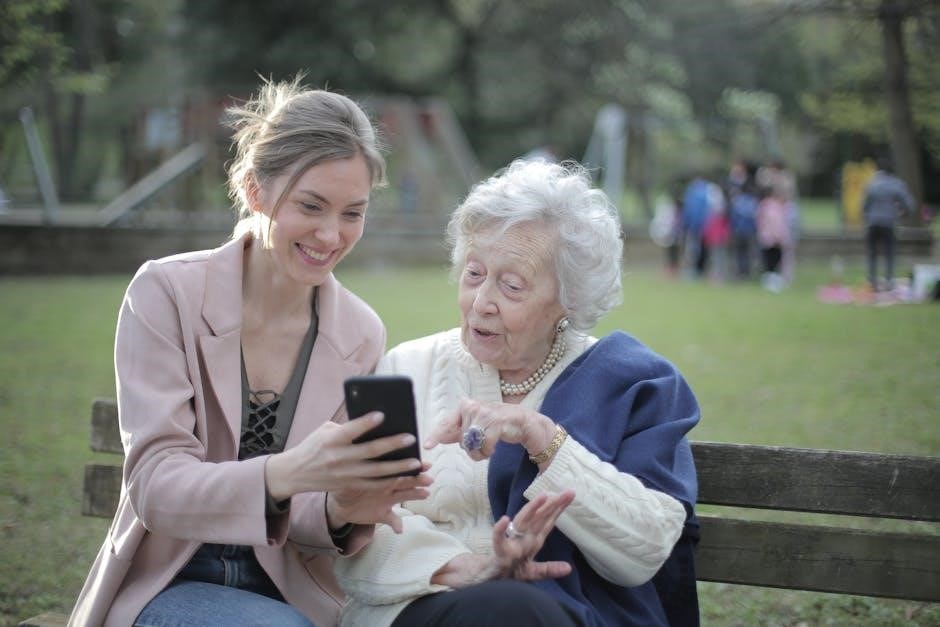
Set in 1960s Jackson, Mississippi, The Help by Kathryn Stockett explores the lives of black maids in a racially charged society, uncovering themes of injustice and empowerment.
Setting the Stage: Jackson, Mississippi in the 1960s
Jackson, Mississippi, in the 1960s, is the backdrop of Kathryn Stockett’s The Help, a era marked by intense racial and social tensions. The Civil Rights Movement was gaining momentum, yet segregation and discrimination remained deeply entrenched. The city’s rigid social hierarchy and limited opportunities for African Americans created a volatile atmosphere. Black maids, like Aibileen and Minny, worked in white households, often facing exploitation and disrespect. This setting of fear and oppression also fostered quiet acts of resistance, as characters began to challenge the status quo through courage and unity.

Book Summary
The Help by Kathryn Stockett tells the story of black maids in 1960s Jackson, Mississippi, navigating racial tension, personal struggles, and societal change, seeking justice and empowerment.
Plot Overview: The Struggle of Black Maids in a Racist Society
The Help follows Aibileen and Minny, black maids in 1960s Jackson, Mississippi, as they endure racial discrimination and mistreatment while working for white families. The story explores their courage in sharing their experiences with Skeeter, a young white writer, despite the risks. Through their narratives, the novel reveals the deeply entrenched racial divide and the hidden alliances that emerge, leading to a powerful expose of the truth and sparking societal change. The plot highlights the resilience of these women as they seek justice and empowerment in a divided world.
Detailed Chapter Analysis
The novel is divided into 18 chapters, each advancing the plot and deepening character development. From introducing key characters to the climax of the book’s publication, the chapters reveal the progression of racial tensions, alliances, and societal shifts in 1960s Mississippi.
Chapters 1-4: Introducing Key Characters and Conflicts
Chapters 1-4 of The Help introduce the core characters and the central conflicts of the novel. Aibileen Clark, a wise and experienced black maid, is introduced as she begins working for the Leefolt family, caring for their young daughter, Mae Mobley. Meanwhile, Skeeter Phelan, an aspiring writer, returns home with ambitions to challenge the status quo. These chapters set the stage for the racial tensions and societal norms that govern life in Jackson, Mississippi, during the 1960s. The seeds of rebellion and change are planted as Skeeter begins to explore the stories of the black maids, highlighting the risks and challenges they face in a deeply segregated society.
Chapters 5-6: The Turning Point for Skeeter and Aibileen
Chapters 5-6 mark a pivotal moment as Skeeter and Aibileen’s relationship deepens. Skeeter, determined to expose the truth, begins secretly gathering stories from the maids, while Aibileen cautiously shares her experiences. These chapters highlight the risks involved, as Skeeter’s ambition clashes with the dangerous realities of challenging racial norms. Aibileen’s courage grows, and the two form an unlikely alliance, setting the stage for the broader rebellion against injustice in their community. This turning point underscores the power of collaboration and the escalating tensions in Jackson.
Chapters 7-9: Escalating Tensions and Hidden Alliances
Chapters 7-9 delve into the intensifying conflicts and secret collaborations. Skeeter, Aibileen, and Minny navigate growing risks as their stories gain momentum. Tensions rise within the community, with white employers becoming suspicious of their maids. Meanwhile, the hidden alliances among the black maids strengthen, creating a sense of unity and purpose. These chapters highlight the courage required to challenge the status quo, as the stakes grow higher for everyone involved, leading to a climactic shift in the narrative.
Chapters 10-13: The Publication of the Controversial Book
Chapters 10-13 mark a pivotal moment as the controversial book, detailing the experiences of black maids, is published. The anonymous narratives spark outrage and curiosity, dividing the community. Skeeter, Aibileen, and Minny face heightened risks, with suspicions growing among their employers. Despite the backlash, the book resonates deeply, challenging the status quo and inspiring quiet revolutions. This section underscores the power of truth and the courage required to confront societal norms, leading to both triumph and turmoil for the women involved.
Chapters 14-18: The Aftermath and Social Change
Chapters 14-18 depict the fallout from the book’s publication, as Jackson’s social dynamics shift. Aibileen faces consequences, losing her job, while Minny struggles with newfound freedom. Skeeter’s reputation is tarnished, but her career gains momentum. The community grapples with exposed truths, leading to subtle yet significant changes. Relationships evolve, and some white women begin to question their biases. These chapters highlight the personal costs of challenging the status quo and the gradual, hard-won progress toward equality and understanding in a deeply divided society.
Themes and Symbolism
Racial injustice, female empowerment, and the power of storytelling are central themes. The novel symbolizes the struggle for equality and the transformative impact of truth and unity in a divided society.
Racial Injustice and the Civil Rights Movement
The novel vividly portrays the pervasive racial injustice faced by black maids in 1960s Mississippi. Set against the backdrop of the Civil Rights Movement, it highlights the exploitation and discrimination black women endured while working in white households. Through characters like Aibileen and Minny, Stockett sheds light on the systemic racism and segregation that defined their lives. The story underscores the courage of these women as they risk everything to challenge the status quo, contributing to the broader struggle for equality and justice during this tumultuous era.
Female Empowerment and Unity
The Help emphasizes the strength found in unity among women, particularly black maids and their white employer Skeeter. Despite societal divides, these women form unlikely alliances, challenging norms and supporting one another. Aibileen, Minny, and Skeeter exemplify female empowerment by sharing their stories and standing against oppression. Their collective efforts not only inspire change but also highlight the transformative power of solidarity and shared purpose. This theme resonates deeply, showing how women can overcome adversity through courage, trust, and mutual support. The novel celebrates their resilience and unity in the face of systemic inequality.
The Power of Storytelling and Truth
The Help underscores the transformative power of storytelling and truth. By documenting their experiences, the maids and Skeeter expose the harsh realities of racial inequality and injustice. Their stories, though risky to share, become a catalyst for change, challenging societal norms and fostering understanding. The novel highlights how truth-telling can empower individuals and communities, bridging divides and sparking necessary conversations about race and humanity. Through their narratives, the characters illustrate the enduring impact of honesty and the importance of giving voice to the silenced.

Character Studies
The Help centers on three key characters: Aibileen, Minny, and Skeeter. Each embodies resilience, courage, and determination, driving the story’s exploration of race, justice, and empowerment.
Aibileen Clark: The Voice of Wisdom and Strength
Aibileen Clark, a Black woman in her fifties, is a central narrator and a symbol of resilience. Working as a maid for the Leefolt family, she cares deeply for Mae Mobley, the child she nurtures. Aibileen’s wisdom and strength shine through her calm demeanor and insightful perspectives on race and inequality. Having lost her own son, Treelore, she channels her pain into advocating for justice. Her leadership among the maids and collaboration with Skeeter make her a pivotal figure in exposing the truths of their oppressed lives in 1960s Mississippi.
Minny Jackson: The Courageous and Outspoken Maid
Minny Jackson, a bold and outspoken Black maid, is known for her sharp wit and unfiltered honesty. Despite the risks, she fearlessly shares her experiences, becoming a key contributor to Skeeter’s book. Minny’s courage is evident in her defiance of societal norms, even when it endangers her. Her loyalty to friends like Aibileen and her determination to expose injustice make her a formidable character. Minny’s story highlights the struggles of Black domestic workers and their fight for respect and equality in a segregated society.
Skeeter Phelan: The Aspiring Writer and Catalyst for Change
Skeeter Phelan, a young white woman, stands out in her conservative community with her progressive views and ambition to become a writer. Unlike her peers, she sees beyond the racial divide, empathizing with the Black maids who toil in silence. Her desire to tell their stories sparks a daring project, challenging the norms of her society.
Through her collaboration with Aibileen and Minny, Skeeter risks everything to expose the truth about the maids’ lives. Her journey reflects personal growth and a commitment to justice, making her a pivotal figure in the fight against racial inequality.

Historical Context
Set in 1960s Jackson, Mississippi, during the Civil Rights Movement, The Help highlights the era’s racial tensions and the struggles of Black domestic workers in a segregated society.
The Civil Rights Movement in 1960s Mississippi
The 1960s in Mississippi were marked by intense racial segregation and violence, with the Civil Rights Movement gaining momentum. African Americans faced systemic oppression, including restricted voting rights and segregated public spaces. The NAACP and other organizations played crucial roles in challenging these injustices. In Jackson, where The Help is set, Black communities endured daily humiliations and fears, while white society clung to traditional hierarchies. This volatile backdrop shaped the lives of characters like Aibileen and Minny, highlighting the era’s struggles and the quiet resistance of Black domestic workers.
The Role of Black Domestic Workers in the South
Black domestic workers, like Aibileen and Minny in The Help, were integral to Southern households yet marginalized. They managed childcare, cleaned homes, and cooked meals, often under exploitative conditions. Despite their crucial roles, they faced racial discrimination, low wages, and lack of respect. Their work was undervalued, reflecting broader societal prejudices. These women’s stories, as depicted in the novel, reveal resilience and quiet acts of defiance, challenging the oppressive norms of their time and contributing to the broader fight for equality during the Civil Rights era.

Social Impact and Legacy
The Help sparked significant conversations about racial injustice, leading to increased book sales and a successful film adaptation, cementing its influence in popular culture and social discourse.
Reception of the Book and Its Adaptation
The Help became a bestseller, staying on the New York Times list for over 100 weeks. The 2011 film adaptation, starring Emma Stone and Viola Davis, earned widespread acclaim and multiple Academy Award nominations, further amplifying its reach. Critics praised its portrayal of racial dynamics, though some noted limitations in representing the full complexity of black experiences. The book and film sparked essential conversations about race and empowerment, leaving a lasting cultural impact and solidifying its place in modern literature and cinema.
Cultural Significance and Modern Relevance
The Help holds significant cultural value for its unflinching portrayal of racial injustice and female empowerment. Set in 1960s Mississippi, it sheds light on the experiences of black domestic workers, sparking conversations about systemic racism and inequality. The novel’s exploration of unity and resilience resonates today, making it a timeless commentary on social justice. Its impact extends beyond literature, influencing film and public discourse, ensuring its relevance in contemporary discussions about race, gender, and storytelling’s power to drive change and understanding.
The Help remains a powerful exploration of racial injustice and female empowerment, offering timeless lessons on courage, unity, and the enduring impact of storytelling in fostering change.
Final Thoughts on the Novel’s Message
The Help delivers a profound message about racial injustice and female empowerment, highlighting the resilience of black maids in 1960s Mississippi. Through their stories, Kathryn Stockett sheds light on the deep-seated prejudices of the time while celebrating the courage and unity of women who dared to challenge the status quo. The novel underscores the transformative power of truth and storytelling, leaving readers with a lasting reflection on equality, justice, and the importance of human connection across racial divides.
Recommendations for Further Reading
For a deeper understanding of the themes in The Help, consider exploring other works on racial injustice and female empowerment. Books like To Kill a Mockingbird and The Secret Life of Bees offer similar insights into the Civil Rights era. Non-fiction works, such as The Warmth of Other Suns by Isabel Wilkerson, provide historical context on African American experiences. Additionally, essays by Patricia Hill Collins on black feminist thought can enrich your perspective on the novel’s themes. These resources complement the PDF summaries and analyses available online, offering a well-rounded exploration of the book’s message and historical significance.